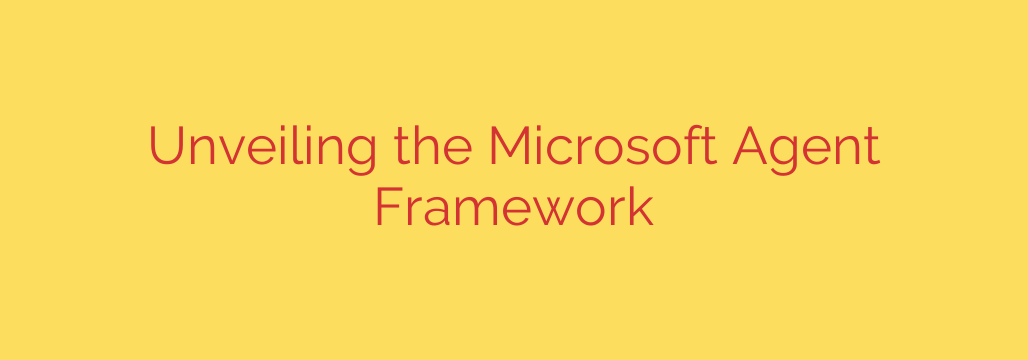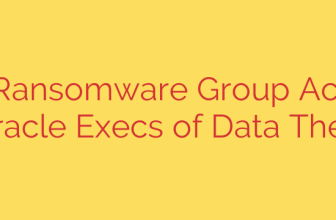
Decoding the Microsoft Agent Framework: The Next Leap in Autonomous AI
The landscape of artificial intelligence is rapidly evolving. We’ve moved beyond simple chatbots and predictive text to the dawn of a new era: autonomous AI agents. These aren’t just tools that respond to commands; they are intelligent systems capable of planning, reasoning, and executing complex, multi-step tasks on their own. At the forefront of this revolution is the newly unveiled Microsoft Agent Framework, a powerful platform poised to redefine automation and digital assistance.
This framework isn’t just another AI model. It’s a comprehensive ecosystem designed to build, manage, and deploy sophisticated AI agents that can interact with digital environments, use tools, and achieve high-level goals with minimal human intervention. Let’s explore what makes this framework a game-changer.
What is an Autonomous AI Agent?
Before diving into the framework itself, it’s crucial to understand what we mean by an “autonomous agent.” Think of it as a digital employee or a highly capable personal assistant. You provide a high-level objective—for example, “Research the top three competitors in the e-commerce space and create a summary presentation”—and the agent takes it from there.
It independently breaks the goal down into smaller steps, decides which tools to use (like a web browser, a document editor, or a data analysis API), executes those steps, learns from the results, and delivers a final product. This is a significant leap from traditional AI, which typically requires step-by-step instructions.
The Core Components of the Microsoft Agent Framework
The power of this framework lies in its modular architecture, which brings together several key components to enable intelligent, autonomous behavior.
- The Orchestrator: This is the central “brain” of the agent. The orchestrator receives the user’s high-level goal and, using a large language model (LLM), creates a strategic plan. It deconstructs the objective into a logical sequence of tasks and determines the best tools or skills needed for each step.
- Large Language Models (LLMs): At the heart of the agent’s reasoning capabilities are advanced LLMs. These models provide the cognitive power for understanding user intent, planning, problem-solving, and generating human-like responses.
- The Skill & Tool Library: An agent is only as capable as the tools it can use. The framework allows developers to equip agents with a library of “skills”—functions, APIs, scripts, or connections to other software. This could include the ability to search the web, send emails, access a database, analyze a spreadsheet, or write code.
- Memory: For an agent to be truly effective, it needs context. The framework includes a sophisticated memory system that enables agents to recall past interactions, learn from previous tasks, and maintain context over long conversations. This includes both short-term memory for the current task and long-term memory for user preferences and learned information.
How It Works: From Goal to Execution
Imagine you task an agent with planning a business trip. The process within the Microsoft Agent Framework would look something like this:
- Goal Ingestion: The user inputs: “Book a round-trip flight to San Francisco and a hotel for the tech conference from June 10th to 12th, keeping the total cost under $1,200.”
- Planning Phase: The Orchestrator receives the goal. It recognizes it needs to perform several sub-tasks: search for flights, find hotels near the conference venue, compare prices, and make bookings.
- Tool Selection: The agent accesses its Tool Library. It identifies the need for a flight booking API, a hotel search API, and perhaps a mapping tool to check hotel proximity.
- Execution & Reasoning: The agent executes the flight search first, using the dates provided. It analyzes the results, cross-references them with the budget constraint stored in its Memory, and provisionally selects an option. It repeats this process for the hotel.
- Self-Correction: If the initial flight and hotel options exceed the budget, the agent will reason that it needs to adjust its plan. It might look for flights on slightly different days or search for hotels in a nearby area and check transit times.
- Final Output: Once it has found a combination that meets all constraints, the agent presents the complete itinerary to the user for final approval before making any purchases.
The Critical Importance of Security and Control
Giving AI agents the autonomy to act on our behalf introduces significant security considerations. An agent with access to company data, cloud infrastructure, or financial accounts is a powerful tool, but also a potential vulnerability. Recognizing this, a core part of building responsible AI agents involves implementing robust safety measures.
Key security risks include:
- Unauthorized Actions: A compromised or poorly configured agent could potentially delete files, send unauthorized emails, or make unintended purchases.
- Prompt Injection: Malicious actors could try to trick the agent into performing harmful actions by embedding hidden instructions in the data it processes.
- Data Leakage: An agent with access to sensitive information could inadvertently expose it if not properly secured.
Actionable Security Best Practices
For any organization looking to leverage this technology, implementing a security-first approach is non-negotiable.
- Implement Strict Sandboxing: Ensure agents operate in a controlled, isolated environment where their access to the broader system is limited.
- Enforce the Principle of Least Privilege: Grant agents only the absolute minimum permissions and access to tools required to perform their specific function.
- Require Human-in-the-Loop Approval: For critical, irreversible, or high-cost actions (like deploying code, deleting a database, or spending money), always require confirmation from a human user.
- Maintain Comprehensive Logs: Keep detailed, immutable logs of every action an agent takes. This is essential for auditing, troubleshooting, and investigating any potential security incidents.
The Microsoft Agent Framework represents a monumental step toward a future where AI transitions from a passive tool to an active partner. By enabling the creation of autonomous agents that can reason, plan, and execute, it opens up limitless possibilities for automation and efficiency. However, harnessing this power responsibly requires a deep commitment to security, control, and ethical design.
Source: https://azure.microsoft.com/en-us/blog/introducing-microsoft-agent-framework/








